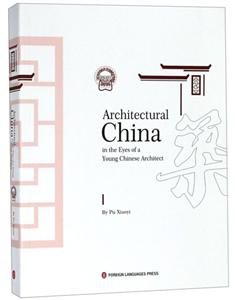掃一掃
關注中圖網(wǎng)
官方微博
本類五星書更多>
-
>
考研英語背單詞20個詞根詞綴
-
>
西班牙語詞根寶典
-
>
美國K-12原版語文課本--初中·下(全12冊)
-
>
流浪地球劉慈欣
-
>
西南聯(lián)大英文課 輕讀禮盒版
-
>
英語大書蟲世界經(jīng)典名譯典藏書系:中國人的精神 (英漢對照)(精選權(quán)威版本)
-
>
許淵沖譯唐詩三百首:漢文·英語
建筑里的中國(英) 版權(quán)信息
- ISBN:9787119119335
- 條形碼:9787119119335 ; 978-7-119-11933-5
- 裝幀:一般膠版紙
- 冊數(shù):暫無
- 重量:暫無
- 所屬分類:>>
建筑里的中國(英) 內(nèi)容簡介
這本書以建筑的物質(zhì)性、社會性和知識性的“三性耦合”作為理論框架,以典型的中國民居代表:西北窯洞、福建客家土樓、山西晉商大院、徽派民居、苗族吊腳樓、北京四合院來展現(xiàn)中國的建筑文脈,并且分析其歷史緣起、發(fā)展軌跡和方向目標。
建筑里的中國(英) 目錄
CHAPTER 1
Chinese Architecture: Three-Trait Coupling
The Origin of“Three-Trait Coupling”
The Material Trait of.Architecture
The Social Trait of Architecture
The Knowledge Trait of Architecture
The Architectural Significance of “‘Ihree-Trait Coupling”
CHAPTER 2
Philosophical Thinking on Natural Residence:
History of Cave Dwellings
Harmony between Human and Heaven: Natural Abode
Xun, Shadow Play and Cave Dwelling
Various Forms of the Traditional Cave Dwelling
The Construction and Decoration of Cave Dwellings
Inspiration from the Earth
Reform and Renewal of the Cave Dwelling
Dialogue between Louis Isadore Kahn and Lao Zi
CHAPTER 3
Ten Thousand Buildings Towering in a Misty Landscape:
Picturesque Scenery with Tulou Architecture
Tulous of the Hakkas
Following Nature and Adapting to Local Conditions
Architectural Wonders without Any Specific Architect
A Utopia with a Communal System
The Tulou in Modern Society
CHAPTER 4
Subtle Reflections of the Great Journey of Humankind:
Courtyard Manors by Shanxi Merchants in the Course
of History
From Cave Dwellings to Brick-and-Tile Quadrangles
Currency Revolution and Vicissitudes of Courtyard Residences
As the Scenery Changes, So Do Your Emotions
Elaborate Exquisiteness of Qiao, Bold Majesty of Wang, and Refined Elegance of Chang
Rites and Order
Merchants and Confucianism
Metaphysics and Fengshui
Calligraphy and Architecture
CHAPTER 5
Huizhou Architecture amidst Mountanis and rivers
Ecological Space amidst Mountains and Rivers
Beauty in the Planning of Clan Settlement
Combined Confucian and Taoist Styles with Plainness and Ethereal Beauty
Huizhou Merchants: Both Businessmen and Confucian Scholars
Thriving Education in the Hometown of Zhu Xi
Connotations of the Patio Culture
Ambiguity and Permeability of the Patio
CHAPTER 6
Flying Eaves Rising among Rolling Mountain Ranges:
Miao Village in Xijiang
Nest Dwelling as the Origin
People Believing Divinity in Everything
Body Aesthetics Reflected in Miao Dwellings
Organic Building Developed from the Environment
Stilted Bottom Story and Utilization of Grey Space
Cultural Significance of Triple Spaces
CHAPTER 7
Cultural Traits Embodied in Square and Circular Spaces:
Miniaturized Cosmos in Quadrangle Courtyards
Vicissitudes over Eight Hundred Years
Dialogue between Gates and Hutongs
Embodiment of Quadrangle Space in Other Cultures
Appreciating Beauty of the Quadrangles
Discovering the Subtleties of Residences of Celebritie
Living in the Leisurely Enclosure of the Quadrangle Courtyards
Protecting the Symbol of Beijing
CHAPTER 8
Words Not to Be Taken as Ending
Postface
Bibliography
Chinese Architecture: Three-Trait Coupling
The Origin of“Three-Trait Coupling”
The Material Trait of.Architecture
The Social Trait of Architecture
The Knowledge Trait of Architecture
The Architectural Significance of “‘Ihree-Trait Coupling”
CHAPTER 2
Philosophical Thinking on Natural Residence:
History of Cave Dwellings
Harmony between Human and Heaven: Natural Abode
Xun, Shadow Play and Cave Dwelling
Various Forms of the Traditional Cave Dwelling
The Construction and Decoration of Cave Dwellings
Inspiration from the Earth
Reform and Renewal of the Cave Dwelling
Dialogue between Louis Isadore Kahn and Lao Zi
CHAPTER 3
Ten Thousand Buildings Towering in a Misty Landscape:
Picturesque Scenery with Tulou Architecture
Tulous of the Hakkas
Following Nature and Adapting to Local Conditions
Architectural Wonders without Any Specific Architect
A Utopia with a Communal System
The Tulou in Modern Society
CHAPTER 4
Subtle Reflections of the Great Journey of Humankind:
Courtyard Manors by Shanxi Merchants in the Course
of History
From Cave Dwellings to Brick-and-Tile Quadrangles
Currency Revolution and Vicissitudes of Courtyard Residences
As the Scenery Changes, So Do Your Emotions
Elaborate Exquisiteness of Qiao, Bold Majesty of Wang, and Refined Elegance of Chang
Rites and Order
Merchants and Confucianism
Metaphysics and Fengshui
Calligraphy and Architecture
CHAPTER 5
Huizhou Architecture amidst Mountanis and rivers
Ecological Space amidst Mountains and Rivers
Beauty in the Planning of Clan Settlement
Combined Confucian and Taoist Styles with Plainness and Ethereal Beauty
Huizhou Merchants: Both Businessmen and Confucian Scholars
Thriving Education in the Hometown of Zhu Xi
Connotations of the Patio Culture
Ambiguity and Permeability of the Patio
CHAPTER 6
Flying Eaves Rising among Rolling Mountain Ranges:
Miao Village in Xijiang
Nest Dwelling as the Origin
People Believing Divinity in Everything
Body Aesthetics Reflected in Miao Dwellings
Organic Building Developed from the Environment
Stilted Bottom Story and Utilization of Grey Space
Cultural Significance of Triple Spaces
CHAPTER 7
Cultural Traits Embodied in Square and Circular Spaces:
Miniaturized Cosmos in Quadrangle Courtyards
Vicissitudes over Eight Hundred Years
Dialogue between Gates and Hutongs
Embodiment of Quadrangle Space in Other Cultures
Appreciating Beauty of the Quadrangles
Discovering the Subtleties of Residences of Celebritie
Living in the Leisurely Enclosure of the Quadrangle Courtyards
Protecting the Symbol of Beijing
CHAPTER 8
Words Not to Be Taken as Ending
Postface
Bibliography
展開全部
建筑里的中國(英) 作者簡介
蒲肖依,1989年生于北京。自幼喜丹青,好讀書,游歷廣泛。本科畢業(yè)于加拿大麥吉爾大學建筑系,現(xiàn)為美國耶魯大學建筑系研究生。曾在日本隈研吾建筑都市設計事務所,美國Kohn Pedersen Fox和Pei Partnership等國際著名建筑事務所研習。有《做人與自然的協(xié)調(diào)者》等建筑學評論見諸報章,嘗試將中國傳統(tǒng)文化融入現(xiàn)代建筑語境中。
書友推薦
- >
羅曼·羅蘭讀書隨筆-精裝
- >
龍榆生:詞曲概論/大家小書
- >
羅庸西南聯(lián)大授課錄
- >
隨園食單
- >
朝聞道
- >
經(jīng)典常談
- >
上帝之肋:男人的真實旅程
- >
小考拉的故事-套裝共3冊
本類暢銷

















